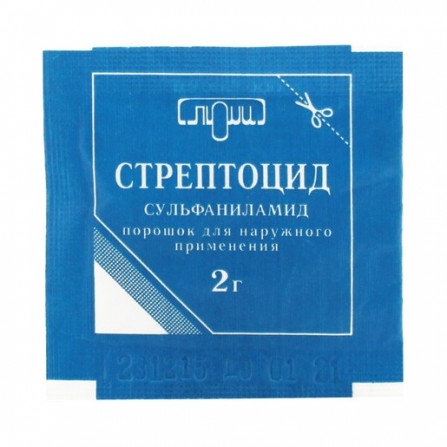Streptocide white powder for external use 2 g
Condition: New product
997 Items
Rating:
Be the first to write a review!

More info
Active ingredients
Sulfanilamide
Release form
Powder
Composition
Sulfanilamide (Sulfanilamide) 2000 mg
Pharmacological effect
Antibacterial agent of a broad spectrum. Sulfanilamide (streptocid) is one of the first representatives of chemotherapeutic agents of the sulfonamide group. It has a bacteriostatic effect. The mechanism of action is due to competitive antagonism with PABK and competitive inhibition of the enzyme dihydropteroate synthetase. This leads to disruption of the synthesis of dihydrofolate and then tetrahydrofolic acid and as a result - to disruption synthesis of nucleic kislot.Sulfanilamid active against Gram-positive and Gram-negative cocci, Escherichia coli, Shigella spp, Vibrio cholerae, Haemophilus influenzae, Clostridium spp, Bacillus anthracis,.. Corynebacterium diphtheriae, Yersinia pestis, as well as for Chlamydia spp., Actinomyces spp., Toxoplasma gondii.
Indications
Streptocid is used in complex therapy for the treatment of purulent wounds, infected burns and other purulent-inflammatory processes of soft tissues.
Contraindications
Hypersensitivity to sulfonamides, pregnancy, lactation. Diseases of the hematopoietic system, inhibition of bone marrow hematopoiesis, anemia, azotemia, thyrotoxicosis, chronic heart failure, renal failure, porphyria, hepatic failure, congenital deficiency of glucose-6-phosphate dehydrogenase.
Precautionary measures
Use with caution in patients with impaired renal function. During the period of treatment it is necessary to increase the amount of fluid consumed.
Use during pregnancy and lactation
It is contraindicated for use in the I and II trimesters of pregnancy and lactation.
Dosage and administration
Streptocide is applied to the wound in the form of a carefully crushed powder (5-10-15 g), if necessary, simultaneously prescribing antimicrobial drugs inside.
Side effects
Allergic reactions, headache, dizziness, nausea, vomiting, dyspepsia, cyanosis, leukopenia, agranulocytosis, crystalluria are possible.
special instructions
When hypersensitivity reactions occur, treatment should be discontinued. With long-term treatment, systematic monitoring of the blood picture, kidney and liver function is recommended.


